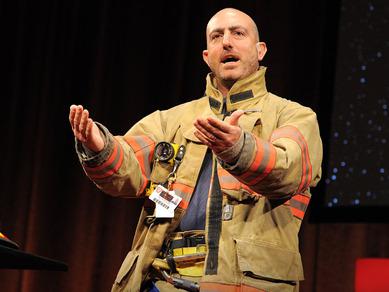A Great Speech: A Firefighter’s Plea To Think Small
Can you move an audience to action in just four minutes?
Volunteer firefighter Mark Bezos—also a senior vice president with a New York-based nonprofit called Robin Hood—proves that you can.
He spoke at a TED (Technology, Entertainment, Design) Conference not long ago about the need to get involved. And it’s one of those videos that moves me every time I see it.
I highly recommend you watch the video. You can read the six reasons his speech worked so well (below) when you finish.
1. He Began With a Small Story: Mark would have flopped if he had started his speech with his call to action, “Don’t wait…if you have something to give, give it now. Get in the game.” By beginning with his story instead, he gave his punch line a power it wouldn’t have otherwise had. You may have heard the expression that audiences can understand a general concept from a specific example, but can’t infer a specific example from a general concept. Mark brilliantly proves why that expression is true.
2. He Used Humor: I’ve written before that being funny isn’t as easy as it looks. I’ve also written that self-effacing humor is often the safest humor to attempt in a speech. Mark’s line, “I know what you’re thinking, but I’m no hero,” elicited a genuine laugh from the audience—and the punch line came (gently) at his own expense.
3. He Didn’t Present Himself as Perfect: I appreciated that Mark allowed a small dose of bitterness—or was it mild envy?—to come through when he referred to his “nemesis,” “Lex Luthor.” Some speakers are reluctant to share that negative emotion, since they prefer painting a more perfect picture of themselves.

4. His Story Contained a Surprise: Since some readers may read this post before watching the video, I won’t spoil the surprise here. But Mark’s surprise ending earned an almost involuntary, audible reaction from the audience.
5. He Had Energy: Mark’s energy served to underscore his message to get in the game. But he was also careful to change his tone and inflection throughout his talk, avoiding what I call “the energetic monotone.”
6. He Looked The Part: Mark’s uniform was a prop (he wasn’t going to be fighting any fires near the stage), but it worked. Some people can use their daily wear to reinforce their message more than others—doctors wearing whites, nurses wearing scrubs, cops wearing uniforms, military members wearing fatigues, and athletes wearing jerseys come to mind.
What do you think? Please leave your thoughts in the comments section below.



If this doesn’t touch you, you’re not human. Great find, Brad. And good takeaways too.
Agree with Chris – nice find, Brad; thanks for sharing and for adding your insight! Sharing now.
I judge any speech by whether or not I want to shake the speaker’s hand afterward. After hearing his speech, I want to travel to New York to shake Mark’s hand. Very well done, and in such a short space of time. Speakers everywhere can learn from this speech.
Touching, humorous, memorable. A speech doesn’t get any better than that.